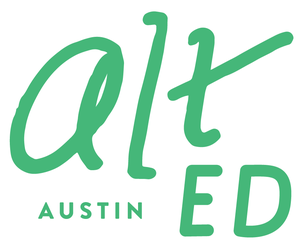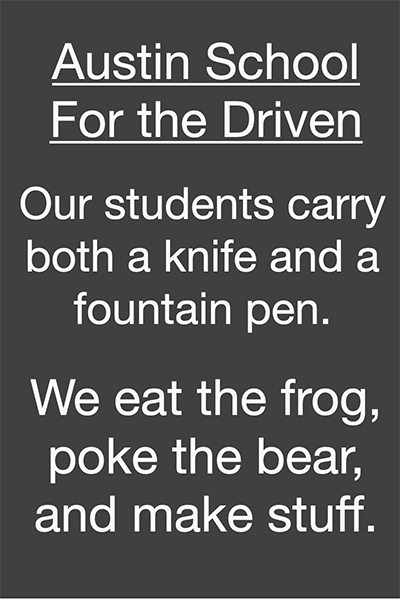Experience learning for yourself
/Educator and community organizer Rachel Green Soto is best known as the founder, director, and teacher of Verona Schoolhouse, a pre-K and kindergarten program in southwest Austin; founder and board chair of the nonprofit Kairos Ed; and founder and executive director of the new Synergy Middle School. Rachel returns to the Alt Ed Austin blog to discuss experiential learning, a mode of education at the center of the Synergy model.
[E]ducation is not what the teacher gives; education is a natural process spontaneously carried out by the human individual. It is not acquired by listening to words, but by experiences upon the environment.
—Maria Montessori, The Absorbent Mind
When I think back on my childhood about where I was and what I was doing when I felt like I grew and learned the most, my mind jumps around between the various experiences I had in and out of school such as:
- practicing for and performing in band concerts
- preparing for and going on a weeklong canoe trip with Girl Scouts
- creating campaigns for student council positions
- volunteering to help students with special needs
- backpacking around Europe with my family
- studying abroad
- working multiple summer jobs
- participating in theatrical performances
- writing for local news publications
Upon reflection, I’ve realized that these experiences have certain elements in common that set them apart from the rest. In each experience, I was:
- actively engaged,
- working with or for the benefit of someone else,
- personally invested in the task, and
- intrinsically motivated by the experience.
According to Wikipedia, “experiential learning is the process of learning through experience, and is more specifically defined as ‘learning through reflection on doing.’” Reflection is a unique element of experiential learning that takes an experience to a whole new level. It is the key to connecting one experience to future learning and experiences, rather than seeing it as a stand-alone event.
What are other characteristics of experiential learning?
Experiential learning takes individual involvement and time. One can’t rush an experience. One can’t force true learning. Through regular interaction in an experience, growth will naturally happen over time. Children don’t learn to walk simply by focusing really hard on the people around them who are already walking, paying close attention, and explaining how walking is done. Rather, they learn to walk by doing the walking . . . with support, with guidance, and with encouragement. Eventually, they will walk because they put that learning into their body, practiced it, and took the time they needed for it all to come together and make sense.
Experiential learning puts its focus on the process rather than the product. Just think of a piece of art. Whether or not it turned out just as it was intended, the experience of doing the work provided growth opportunities that will be built upon the next time.
Experiential learning connects the pieces and creates opportunities for everything to make sense. When I studied abroad in high school and college, many of the separate skills I had been practicing for so long, including speaking a second language, learning about cultures around the world, managing money, and reading maps, came together and made a whole new world of sense in the context of living in another country. I believe that without that experience, those individual pieces would have continued floating around, disconnected with anything real or meaningful.
Experiential learning is multi-sensory. Research has shown that there is an important link between the brain and the body in learning. A multi-sensory approach helps take learning to a deeper level by engaging multiple senses, thus connecting more directly to the individual. Imagine how alive the life sciences could become for you if you were spending time in nature, with its sounds, smells, sights, and energy!
Experiential learning is relevant and motivating. Too often students don’t understand, or can’t clearly explain, why they are learning something that is being taught, right? Many of us have wondered or been asked the question, “But when am I going to use this in the real world?” Now just imagine how motivated a student would be to understand accounting, communication, and writing skills if those activities were part of building their own business from the ground up. Connecting the foundational skills development and content learning to an authentic learning experience flips the script completely. When learners are invested in their ideas and excited about the opportunities, they are open to learning in a whole new way.
Is your experiential learning authentic or vicarious?
As you consider what experiential learning does or could look like in your learning environment, I encourage you also to think additionally about how to connect students to the learning in real, tangible, and motivating ways by making the learning not just experiential but also authentic. Experiential learning moves from vicarious to authentic when it goes beyond textbooks, beyond projects, and beyond the classroom walls to involve real-life skills, with actual deadlines, a real purpose, and results in useful interaction with a community. Real life is full of learning opportunities that, with intentionality, can enrich the foundation and application aspect of any learning environment, providing natural opportunities for deep and relevant learning and skill development.
Middle schoolers learn by doing!
At Synergy Middle School, we have redesigned the middle school experience with authentic experiential learning in mind. We are committed to providing a strong academic foundation of skills and knowledge in the classroom that is clearly relevant and motivating to students through its experiential application.
Not only will Synergy students cover the core content knowledge; but they also will make all of Austin their classroom with weekly experiences on location:
- Rock out with music lessons from Don’t Stop Rockin’
- Hang with aerial yoga at Yogapeutics
- Adventure outdoors all day with Earth Native School
- Perform in a show that you wrote…alongside robots that you programmed with the Paramount Theatre
- Observe and create art traveling around Austin and the Hill Country to see, firsthand, the best art installments; then head to the studio to create your own art at the Art Garage
Every week at Synergy Middle School is designed to weave academic, social, and experiential learning together in the minds, hearts, and bodies of middle schoolers.
We are thrilled to be working with a strong team of skilled teachers in the classroom, expert educators on location, and a growing community of professional support providers that are enthusiastic and committed to creating and supporting a holistic learning environment where all students thrive through their participation in their learning.
Rachel Green Soto






















